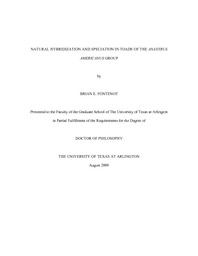| dc.description.abstract | The goal of speciation research is to elucidate the processes that lead to the formation of new species. Examining natural hybridization and the evolution of reproductive isolating barriers provides an opportunity to understand the dynamic processes that occur before, during, and after speciation events. Here, I use true toads of the Anaxyrus americanus group to examine the effects of natural hybridization on (1) the evolution of reproductive isolation using previously published laboratory hybridization data on multiple species within the family Bufonidae, (2) morphological variation using morphometric analysis of known Anaxyrus americanus group hybrids, and (3) molecular variation and genetic population structure in the Anaxyrus americanus group using AFLP markers. First, postzygotic isolation shows a positive correlation with genetic divergence in bufonids, suggesting that diverging species will become increasingly isolated over time, as seen in other organisms. Toads also display some unusual patterns of reproductive isolation in that fertilization rate is not correlated with genetic divergence. Haldane's rule for inviability, strictly obeyed in most taxa, is followed in only 56% of crosses with females the affected sex in 70% of these cases. These results suggest that the homomorphic sex chromosomes seen in true toads and/or maternal effects may play a role in the unusual results regarding Haldane's rule for inviability. Examining offspring for adherence to Haldane's rule for sterility revealed that only males were affected and degree of ploidy in hybrid offspring does not appear to predict sterility. Second, laboratory-produced hybrid offspring between members of the Anaxyrus americanus group can readily be distinguished from putative parental individuals raised under the same laboratory conditions as well as putative parentals collected from current natural populations. Using discriminant function analysis of morphometric characters, hybrid individuals were correctly classified in 84.3% of cases and putative parental individuals were correctly classified in 99.4% of cases. Hybrids deviated from parental species in aspects of cranium and forelimb morphology. Interestingly, hybrids did not possess morphological traits intermediate between that of their respective parental species; instead they display substantial morphological changes distinguishing them from either parental species. Transgressive segregation in morphological traits due to dominance effects at loci involved in complementary gene action could potentially explain these results, although further research is needed before any firm conclusions can be made. Finally, genetic analysis of 100 Amplified Fragment Length Polymorphism (AFLP) loci revealed discrete population structure within and among species, but species in close proximity sharing similar male advertisement calls displayed high levels of gene flow between populations. These results suggest that species in the Anaxyrus americanus group may exist as both distinct populations and as subdivided metapopulations connected by recent or ongoing gene flow, possibly due to natural hybridization. Isolation by distance and prezygotic isolating mechanisms appear to be the primary determinants of population structure within these species. | en_US |

